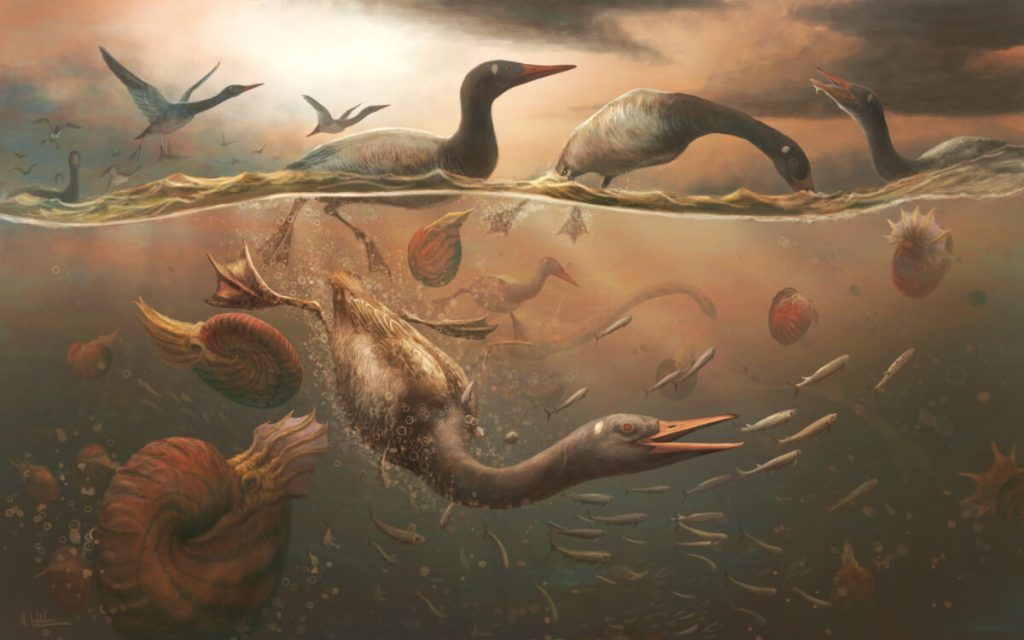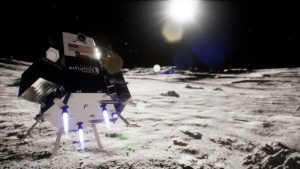

An artist’s interpretation of Vegavis iaai diving for fish in the shallow ocean off the coast of the Antarctic peninsula, with ammonites and plesiosaurs for company. (Credit: Mark Witton)
In a nutshell
- A newly discovered 69-million-year-old bird skull from Antarctica proves that modern birds were already diverse and thriving alongside dinosaurs, challenging previous theories about bird evolution
- The ancient bird Vegavis iaai was related to modern ducks and geese but had a spear-shaped beak and hunted underwater like today’s penguins and loons, showing early birds explored varied lifestyles
- The discovery suggests that modern birds began diversifying before the extinction of non-avian dinosaurs, not after as previously thought, and indicates Antarctica may have played a special role in early bird evolution
STOCKTON, Calif. — A remarkable fossil discovery from Antarctica is rewriting the story of bird evolution. Scientists have unearthed an exceptionally well-preserved skull belonging to Vegavis iaai, a diving bird that swam in Antarctic waters approximately 69 million years ago, during the last days of the dinosaurs. This discovery provides unprecedented insights into how birds evolved and diversified before the extinction event that wiped out the non-avian dinosaurs.
Scientists have long debated when modern birds first emerged and how they developed their incredible diversity of forms and behaviors. While DNA studies consistently suggest that modern birds originated during the Late Cretaceous period, fossil evidence from this crucial time has been frustratingly scarce. As study lead author Chris Torres, an assistant professor at the University of the Pacific, notes, “There are very few brains to illuminate this phase of avian evolution.”
The newly discovered skull, housed at the American Museum of Natural History, represents one of very few 3D bird skulls known from the Cretaceous period, a 79-million-year span when non-avian dinosaurs still dominated Earth’s landscapes.


Vegavis is already one of the best-understood birds from this era. The species was first identified in 2005 by Julia Clarke and colleagues, working with a specimen discovered on Antarctica’s Vega Island in 1992. That discovery proved that modern bird relatives coexisted with non-avian dinosaurs. In 2016, Clarke’s team found another Vegavis specimen containing the oldest known fossil bird vocal organ. The new skull specimen was discovered during a 2011 Antarctic expedition by study co-author Eric Roberts, a professor at the Colorado School of Mines.
The research team pieced together the Vegavis’ story using advanced technology, including CT scanning that allowed them to see inside the fossil without damaging it. They created detailed 3D models of the skull and compared its features with both living and extinct birds to understand its place in bird evolution.
The skull reveals several innovative features that mark Vegavis as a crown-group bird – meaning it belongs to the same group as modern birds. It had already evolved a toothless beak and showed advanced brain features, including an enlarged cerebrum and repositioned optic lobes, characteristics we associate with modern birds.
Vegavis had powerful jaw muscles, evidenced by deep temporal fossae (depressions in the skull where jaw muscles attached) and a narrow, pointed beak perfect for catching prey underwater. This combination of features suggests it was an accomplished underwater hunter, similar to today’s mergansers (fish-eating ducks), but with even more specialized adaptations for this lifestyle.
“Few birds are as likely to start as many arguments among paleontologists as Vegavis,” says Torres, referring to ongoing debates about where this species fits in the bird family tree. The new study finally provides strong evidence that Vegavis belongs among the anseriforms — the group including modern ducks and geese — though it looked quite different from its modern relatives.
As Clarke notes, “In the past they were weird and wonderful. We have this huge range [of now-extinct anseriform birds] and Vegavis is consistent with that.” The species had a long, spear-shaped beak unlike any modern duck or goose, leading Clarke to observe that “it gave some people pause. They expected [the skull] to be more duck or goose-like.”


This study, published in Nature, helps answer a crucial question about bird evolution: Did modern birds begin diversifying before or after the extinction of non-avian dinosaurs? The evidence suggests this diversification was already well underway during the Age of Dinosaurs, with birds exploring different lifestyles and body plans long before the extinction event.
The Antarctic location of these fossils may hold additional clues about early bird evolution. “Something very different seems to have been happening in the far reaches of the Southern Hemisphere, specifically in Antarctica,” says study co-author Patrick O’Connor. “This requires a much closer look into the fossil record and the changing environments of this region through time.”
During the late Cretaceous period, this region was warmer than today but still experienced months of darkness during winter. Vegavis would have needed to be well-adapted to hunting in low-light conditions, perhaps explaining some of its specialized features.
“This new fossil reveals that Antarctica has much to tell us about the earliest stages of modern bird evolution,” says Clarke.
Paper Summary
Methodology
The research team employed several sophisticated techniques to study the fossil. They used X-ray micro-computed tomography (µCT scanning) at multiple facilities to create detailed three-dimensional reconstructions of the skull. These scans were performed at different stages during the specimen’s preparation, allowing researchers to see details that wouldn’t be visible to the naked eye. The team then used specialized software to digitally prepare and analyze the specimen, creating detailed models of individual bones and the brain cavity.
Results
The analysis revealed several groundbreaking findings. The skull showed a unique combination of features, including enlarged jaw muscles, a specialized bill shape, and advanced brain characteristics typical of modern birds. The team’s phylogenetic analysis (family tree reconstruction) placed Vegavis firmly within the group of modern birds, specifically as a relative of ducks and geese, but with adaptations for underwater hunting that aren’t seen in its modern relatives.
Limitations
While the skull is remarkably complete, some portions are missing or damaged, and certain features couldn’t be fully assessed. Additionally, as with all fossil studies, there’s an inherent limitation in what can be determined about soft tissues and behaviors based solely on preserved bones.
Discussion and Takeaways
This study fundamentally changes our understanding of early bird evolution, demonstrating that modern-type birds were already quite diverse and specialized before the extinction event that killed the dinosaurs. It suggests that the early evolution of birds included many “evolutionary experiments” that aren’t represented in modern species.
Funding and Disclosures
The research was funded by the National Science Foundation, with Torres conducting the research as an NSF postdoctoral fellow at Ohio University. The study represents a collaboration between multiple institutions including the University of Texas at Austin, Ohio University, Carnegie Museum of Natural History, American Museum of Natural History, and the Smithsonian National Museum of Natural History.
Publication Information
The study “Cretaceous Antarctic bird skull elucidates early avian ecological diversity” was published in Nature on February 5, 2025. DOI: 10.1038/s41586-024-08390-0








